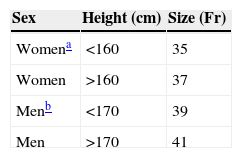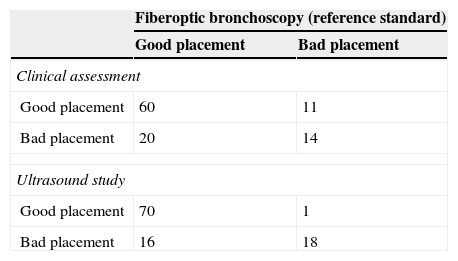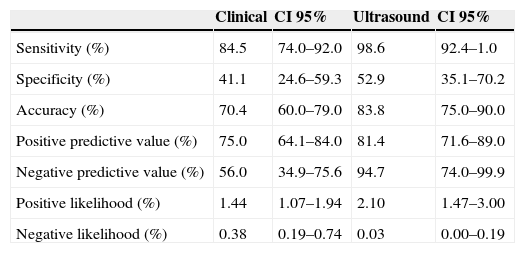To compare the ability of lung ultrasound and a clinical method in the confirmation of a selective bronchial intubation by left double-lumen tube in elective thoracic surgery.
Material and methodsA prospective and blind, observational study was conducted in the setting of a university hospital operating room assigned for thoracic surgery. A single group of 105 consecutive patients from a total of 130 were included. After blind intubation, the position of the tube was confirmed by clinical and ultrasound assessment. Finally, the fiberoptic bronchoscopy confirmation as a reference standard was used to confirm the position of the tube. Under manual ventilation, by sequentially clamping the tracheal and bronchial limbs of the tube, clinical confirmation was made by auscultation, capnography, visualizing the chest wall expansion, and perceiving the lung compliance in the reservoir bag. Ultrasound confirmation was obtained by visualizing lung sliding, diaphragmatic movements, and the appearance of lung pulse sign.
ResultsThe sensitivity of the clinical method was 84.5%, with a specificity of 41.1%. The positive and negative likelihood ratio was 1.44 and 0.38, respectively. The sensitivity of the ultrasound method was 98.6%, specificity was 52.9%, with a positive likelihood ratio of 2.10 and a negative likelihood ratio of 0.03. Comparisons between the diagnostic performance of the 2 methods were calculated with McNemar's test. There was a significant difference in sensitivity between the ultrasound method and the clinical method (P=.002). Nevertheless, there was no statistically significant difference in specificity between both methods (P=.34). A P value<.01 was considered statistically significant.
ConclusionLung ultrasound was superior to the clinical method in confirming the adequate position of the left double-lumen tube. On the other hand, in confirming the misplacement of the tube, differences between both methods could not be ensured.
Comparar la capacidad de la ecografía pulmonar y del método clínico para confirmar una intubación selectiva mediante un tubo de doble luz izquierdo en cirugía torácica electiva.
Material y métodosEstudio observacional, ciego y prospectivo, realizado en el quirófano de cirugía torácica de un hospital universitario en el que a un grupo de 105 pacientes consecutivos, de un total de 130, tras la intubación traqueal con un tubo de doble luz izquierdo se les confirmó la posición del tubo clínicamente y por ecografía para, finalmente, aplicarles la confirmación fibrobroncoscópica considerada estándar de referencia. Bajo ventilación manual, tras el pinzamiento secuencial de los lúmenes traqueal y bronquial, la confirmación clínica se realizaba mediante auscultación, capnografía, visualización de los movimientos del tórax y percepción de la compliancia pulmonar en la bolsa reservorio. La confirmación ecográfica se practicaba mediante la visualización del deslizamiento pulmonar, los movimientos diafragmáticos y la aparición del signo pulso pulmón.
ResultadosLa sensibilidad del método clínico fue del 84,5%, la especificidad fue del 41,1%, el cociente de probabilidad positivo fue 1,44, y el cociente de probabilidad negativo fue 0,38. La sensibilidad del método ecográfico fuel 98,6%, la especificidad fue del 52,9%, el cociente de probabilidad positivo fue 2,10, y el cociente de probabilidad negativo fue 0,03. La comparación del contraste de sensibilidades y especificidades de ambos métodos se realizó mediante el test de McNemar. Había una diferencia significativa entre la sensibilidad del método ecográfico y el método clínico (p=0,002), no encontrándose diferencia significativa entre las especificidades de ambos test (p=0,34). El nivel de significación estadístico considerado fue p<0,01.
ConclusiónEl método ecográfico fue superior al clínico para comprobar la correcta colocación del tubo de doble luz izquierdo, pero para diagnosticar la malposición del tubo no se puede asegurar que haya diferencias entre ambos métodos.












